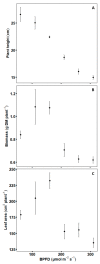Modelling of Soybean (Glycine max (L.) Merr.) Response to Blue Light Intensity in Controlled Environments
- PMID: 33322490
- PMCID: PMC7764200
- DOI: 10.3390/plants9121757
Modelling of Soybean (Glycine max (L.) Merr.) Response to Blue Light Intensity in Controlled Environments
Abstract
Low photosynthetic photon flux density (PPFD) under shade is associated with low blue photon flux density (BPFD), which independent from PPFD can induce shade responses, e.g., elongation growth. In this study, the response of soybean to six levels of BPFD under constant PPFD from LED lighting was investigated with regard to morphology, biomass and photosynthesis to increase the knowledge for optimizing the intensity of BPFD for a speed breeding system. The results showed that low BPFD increased plant height, leaf area and biomass and decreased leaf mass ratio. Photosynthetic rate and internode diameter were not influenced. A functional structural plant model of soybean was calibrated with the experimental data. A response function for internode length to the perceived BPFD by the internodes was derived from simulations and integrated into the model. With the aim to optimize lighting for a speed breeding system, simulations with alternative lighting scenarios indicated that decreasing BPFD during the growth period and using different chamber material with a higher reflectance could reduce energy consumption by 7% compared to the experimental setup, while inducing short soybean plants.
Keywords: LED lighting; blue photon flux density; functional structural plant modelling; indoor farming; photomorphogenesis.
Conflict of interest statement
The authors declare no conflict of interest and the funders had no role in the design of the study; in the collection, analyses, or interpretation of data; in the writing of the manuscript, or in the decision to publish the results.
Figures







References
-
- Bantis F., Smirnakou S., Ouzounis T., Koukounaras A., Ntagkas N., Radoglou K. Current status and recent achievements in the field of horticulture with the use of light-emitting diodes (LEDs) Sci. Hortic. 2018;235:437–451. doi: 10.1016/j.scienta.2018.02.058. - DOI
-
- Singh D., Basu C., Meinhardt-Wollweber M., Roth B. LEDs for energy efficient greenhouse lighting. Renew. Sustain. Energy Rev. 2015;49:139–147. doi: 10.1016/j.rser.2015.04.117. - DOI
-
- Olle M., Viršile A. The effects of light-emitting diode lighting on greenhouse plant growth and quality. Agric. Food Sci. 2013;22:223–234. doi: 10.23986/afsci.7897. - DOI
-
- Ahlman L., Bånkestad D., Wik T. Using chlorophyll a fluorescence gains to optimize LED light spectrum for short term photosynthesis. Comput. Electron. Agric. 2017;142:224–234. doi: 10.1016/j.compag.2017.07.023. - DOI
-
- Pennisi G., Blasioli S., Cellini A., Maia L., Crepaldi A., Braschi I., Spinelli F., Nicola S., Fernandez J.A., Stanghellini C., et al. Unraveling the role of red:blue LED lights on resource use efficiency and nutritional properties of indoor grown sweet basil. Front. Plant Sci. 2019;10:305. doi: 10.3389/fpls.2019.00305. - DOI - PMC - PubMed
Grants and funding
LinkOut - more resources
Full Text Sources

